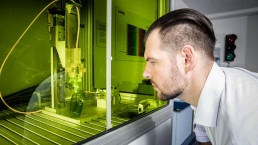We are exposed to various sources of light on a daily basis. However, many of these are dangerous for our bodies – because of what’s known as artificial optical radiation. Find out exactly what artificial optical radiation is and how you can protect yourself against it in this blog article.
What is artificial optical radiation?
With torches and candles, mankind succeeded in literally lighting the darkness. Today, light is much more than just something that helps us see at night, it’s become a tool of our modern society. From illuminated smartphone displays to laser headlights with a range of over 1 km to floodlights that light up entire stadiums – this huge light output is only possible thanks to artificial optical radiation. Artificial optical radiation includes all electromagnetic radiation in a wavelength spectrum of 100 nm to 1 mm. It’s generated by lasers, lamps, radiant heaters, sunbeds and light arcs, for example. In contrast to natural optical radiation, artificial optical radiation can also produce just a narrow spectrum of optical radiation.
Regular long-term exposure to artificial optical radiation may damage your skin and eyes because your body’s instinctive protective reactions are no longer able to protect you sufficiently against it.
Laser safety window from laservision

About laservision:
laservision, a 100% subsidiary of the uvex group, together with its subsidiary in the USA, is one of the world’s leading manufacturers of laser protection products. laservision develops, produces and sells certified laser safety glasses with mineral glass, plastic and/or coated filters. We offer also large-area protection such as laser safety windows, curtains and laser safety barriers for all types of lasers and laser applications worldwide.
The intensive research and manufacturing expertise, as well as the know-how transfer with the uvex safety group are the basis of the daily business of laservision.
laservision customers include manufacturers and users of laser technologies from all areas such as industry, medicine, research or military.
More information about laservision can be found here: https://www.uvex-laservision.de/en
OStrV – Occupational Safety Ordinance on Artificial Optical Radiation
To protect workers who are regularly exposed to artificial optical radiation, the “Ordinance on the Protection of Employees against the Dangers of Artificial Optical Radiation (OStrV)” was published in July 2010 but remains relatively unheard of.
The OStrV stipulates that employers must determine whether artificial optical radiation is or may be present at an employee’s workplace. Thanks to daily exposure to lamps and a wide range of light sources, spotlights, monitors and projectors, it’s almost impossible to avoid being exposed to artificial optical radiation at work. Employers must therefore assess all the resulting risks to employee health and safety. If employers don’t have the right skills to carry out such an assessment, they should consult an expert. This expert may be an external agent or an employee from within their own company who has the necessary expertise.
MTK1 course at the uvex academy
The uvex academy is offering a highly practical two-day training course entitled “Acquiring the technical qualification ‘Measuring artificial optical radiation’ (MTK1)” in order to meet the requirements of the OStrV. The course covers basics including the various sources of artificial optical radiation such as lasers and UV lamps, how to measure artificial optical radiation correctly and how to prepare an OStrV-compliant risk assessment.
Seize the initiative and learn how to protect yourself and your employees against artificial optical radiation. We look forward to welcoming you!